NET 125 Module 12 - IPv6 addressing
1/65
There's no tags or description
Looks like no tags are added yet.
Name | Mastery | Learn | Test | Matching | Spaced |
|---|
No study sessions yet.
66 Terms
IPv6 has a much larger __ bit space
128
The ____ has created various protocols and tools to help network administrators
migrate their networks to IPv6
IETF
The IETF has created various protocols and tools to help network administrators migrate their networks to IPv6. These migration techniques can be divided into three categories: Dual stack
The devices run both IPv4 and IPv6 protocol stacks simultaneously
The IETF has created various protocols and tools to help network administrators migrate their networks to IPv6. These migration techniques can be divided into three categories: Tunneling
method of transporting an IPv6 packet over an IPv4 network. The IPv6
packet is encapsulated inside an IPv4 packet
The IETF has created various protocols and tools to help network administrators migrate their networks to IPv6. These migration techniques can be divided into three categories: Translation
Network Address Translation 64 (NAT64) allows IPv6-enabled devices to communicate with IPv4-enabled devices using a translation technique similar to NAT for IPv4
The first rule to help reduce the notation of IPv6 addresses is to omit any leading 0s (zeros)
Type Format
Preferred 2001 : 0db8 : 0000 : 1111 : 0000 : 0000 : 0000 : 0200
No leading zeros 2001 : db8 : 0 : 1111 : 0 : 0 : 0 : 200
Rule 2 – Double Colon A double colon (::) can replace
any single, contiguous string of one or more 16-bit hextets consisting of all zeros
There are three broad categories of IPv6 addresses:
• Unicast
Unicast uniquely identifies an interface on an IPv6-enabled device
There are three broad categories of IPv6 addresses:
• Multicast
Multicast is used to send a single IPv6 packet to multiple destinations
There are three broad categories of IPv6 addresses:
• Anycast
This is any IPv6 unicast address that can be assigned to multiple devices. A packet sent to an anycast address is routed to the nearest device having that address.
T or F: Unlike IPv4, IPv6 does not have a broadcast address. However, there is an IPv6 all-
nodes multicast address that essentially gives the same result
True
Prefix length is represented in slash notation and is used to indicate the network portion of an IPv6 address. The IPv6 prefix length can range from 0 to ___
128
The recommended IPv6 prefix length for LANs and most other types of networks is
/64
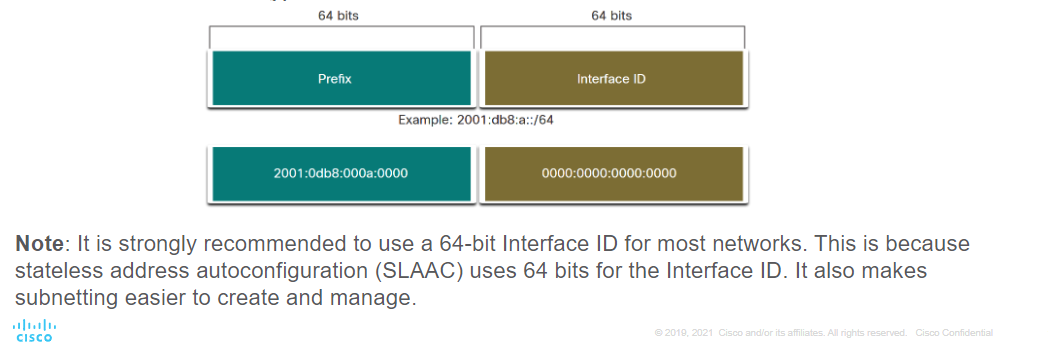
Unlike IPv4 devices that have only a single
address, IPv6 addresses typically have two
unicast addresses:
• Global Unicast Address (GUA)
• Link-local Address (LLA)
Unlike IPv4 devices that have only a single address, IPv6 addresses typically have two unicast addresses: Global Unicast Address (GUA)
This is similar to a public IPv4 address. These are globally unique, internet-routable addresses.
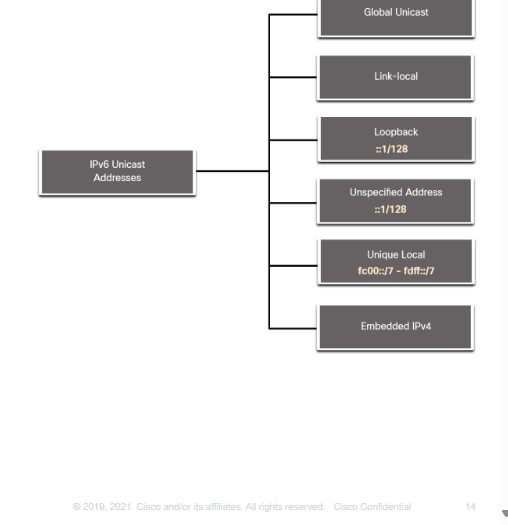
Unlike IPv4 devices that have only a single address, IPv6 addresses typically have two unicast addresses: Link-local Address (LLA)
Required for every IPv6-enabled device and used to communicate with other devices on the same local link. LLAs are not routable and are confined to a single link
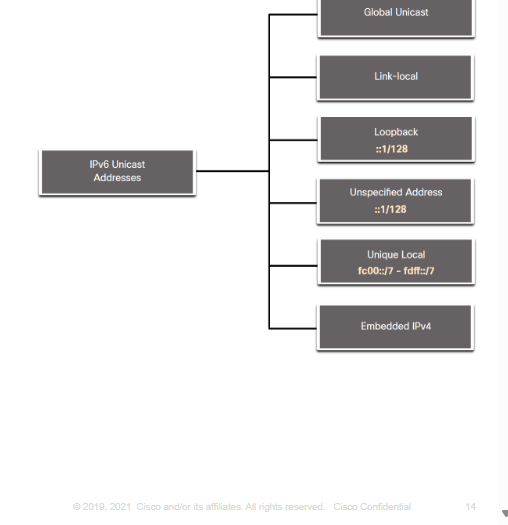
Unique local addresses are used for
local addressing within a site or between a
limited number of sites.
• Unique local addresses can be used for devices that will never need to access
another network.
• Unique local addresses are not globally routed or translated to a global IPv6
address
IPv6 global unicast addresses (GUAs) are
globally unique and routable on the IPv6
internet
Currently, only GUAs
with the first three bits of 001 or 2000::/3 are being assigned.
• Currently available GUAs begins with a decimal 2 or a 3 (This is only 1/8th of the total
available IPv6 address space).
IPv6 GUA Structure: global routing prefix
prefix, or network, portion of the address that is
assigned by the provider, such as an ISP, to a customer or site. The global routing
prefix will vary depending on ISP policies
IPv6 GUA Structure: Subnet ID
the Subnet ID field is the area between the Global Routing Prefix and the
Interface ID. The Subnet ID is used by an organization to identify subnets within
its site
IPv6 GUA Structure: Interface ID
The IPv6 interface ID is equivalent to the host portion of an IPv4 address. It is
strongly recommended that in most cases /64 subnets should be used, which
creates a 64-bit interface ID
Note: IPv6 allows the
all-0s and all-1s host addresses can be assigned to a device. The all-0s address is
reserved as a Subnet-Router anycast address, and should be assigned only to routers
An IPv6 link-local address (LLA) enables a device to
communicate with other IPv6-
enabled devices on the same link and only on that link (subnet).
Packets with a source or destination LLA cannot be
routed
Every IPv6-enabled network interface must have an
LLA
If an LLA is not configured manually on an interface, the device will automatically create
one
IPv6 LLAs are in the ____ range
fe80::/10
The example shows commands to configure a GUA on the G0/0/0 interface on R1:
R1(config)# interface gigabitethernet 0/0/0
R1(config-if)# ipv6 address 2001:db8:acad:1::1/64
R1(config-if)# no shutdown
R1(config-if)# exitThe example shows commands to configure a LLA on the G0/0/0 interface on R1:
R1(config)# interface gigabitethernet 0/0/0
R1(config-if)# ipv6 address fe80::1:1 link-local
R1(config-if)# no shutdown
R1(config-if)# exitDevices obtain GUA addresses dynamically through
Internet Control Message Protocol
version 6 (ICMPv6) messages
Router Solicitation (RS) messages are sent by
host devices to discover IPv6 routers
Router Advertisement (RA) messages are sent by
routers to inform hosts on how to obtain an IPv6 GUA and provide useful network information such as:
• Network prefix and prefix length
• Default gateway address
• DNS addresses and domain name
The RA can provide three methods for configuring an IPv6 GUA:
• SLAAC
• SLAAC with stateless DHCPv6 server
• Stateful DHCPv6 (no SLAAC)
SLAAC allows a device to configure a GUA without the services of
DHCPv6
Method 1: SLAAC: Devices obtain the necessary information to configure a GUA from the ICMPv6 RA messages of the
local router

Method 1: SLAAC: The prefix is provided by the RA and the device uses either the EUI-64 or random
generation method to create an interface ID

Method 2: SLAAC and Stateless DHCP
An RA can instruct a device to use both SLAAC and stateless DHCPv6.
The RA message suggests devices use the following:
• SLAAC to create its own IPv6 GUA
• The router LLA, which is the RA source IPv6 address, as the default gateway address
• A stateless DHCPv6 server to obtain other information such as a DNS server address and a domain name

Method 3: Stateful DHCPv6:
An RA can instruct a device to use stateful DHCPv6 only.
Stateful DHCPv6 is similar to DHCP for IPv4. A device can automatically receive a GUA, prefix length, and the addresses of DNS servers from a stateful DHCPv6 server.
The RA message suggests devices use the following:
• The router LLA, which is the RA source IPv6 address, for the default gateway
address.
• A stateful DHCPv6 server to obtain a GUA, DNS server address, domain name and
other necessary information.

When the RA message is either
SLAAC or SLAAC with stateless
DHCPv6, the client must
generate its own interface ID
The interface ID can be created
using the EUI-64 process or a
randomly generated 64-bit
number
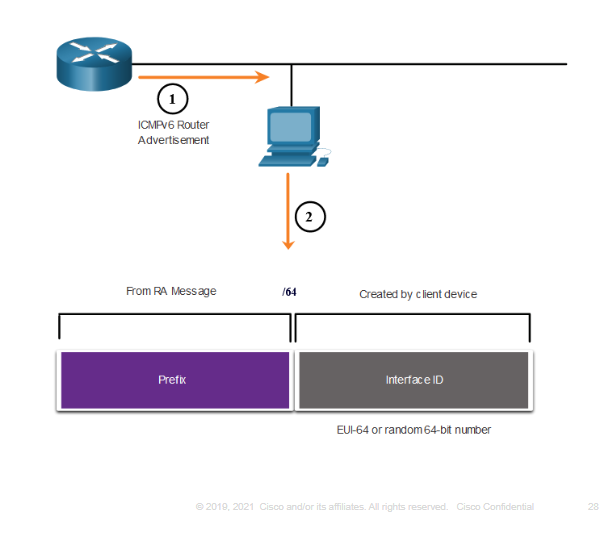
EUI-64 Process
The IEEE defined the Extended Unique Identifier (EUI) or modified EUI-64 process
which performs the following:
A 16 bit value of fffe (in hexadecimal) is inserted into the middle of the 48-bit
Ethernet MAC address of the client.
• The 7th bit of the client MAC address is reversed from binary 0 to 1.
• Example:
48-bit MAC- fc:99:47:75:ce:e0
EUI-64 Interface ID- fe:99:47:ff:fe:75:ce:e0
All IPv6 interfaces must have an
IPv6 LLA
The figure shows the LLA is dynamically created using the fe80::/10 prefix and the
interface ID using the EUI-64 process, or a randomly generated
64-bit number

IPv6 multicast addresses have the prefix ff00::/8. There are two types of IPv6 multicast addresses:
• Well-Known multicast addresses
• Solicited node multicast addresses
Note: Multicast addresses can only be destination addresses and not source addresses
Well-known IPv6 multicast addresses are assigned and are reserved for predefined
groups of devices.
There are two common IPv6 Assigned multicast groups:
ff02::1 All-nodes multicast group
ff02::2 All-routers multicast group
There are two common IPv6 Assigned multicast groups: ff02::1 All-nodes multicast group
This is a multicast group that all IPv6-enabled devices
join. A packet sent to this group is received and processed by all IPv6 interfaces on the link
or network
There are two common IPv6 Assigned multicast groups:
This is a multicast group that all IPv6 routers join. A
router becomes a member of this group when it is enabled as an IPv6 router with the ipv6
unicast-routing global configuration command
A solicited-node multicast address
is mapped to a special
Ethernet
multicast address
IPv6 was designed with subnetting in mind.
• A separate subnet ID field in the IPv6 GUA is used to create
subnets
IPv6 was designed with subnetting in mind.
the subnet ID field is the area between the Global Routing Prefix and the
interface ID
Given the 2001:db8:acad::/48 global
routing prefix with a 16 bit subnet ID.
• Allows 65,536 /64 subnets
• The global routing prefix is the
same for all subnets.
Only the subnet ID hextet is
incremented in hexadecimal for each
subnet.
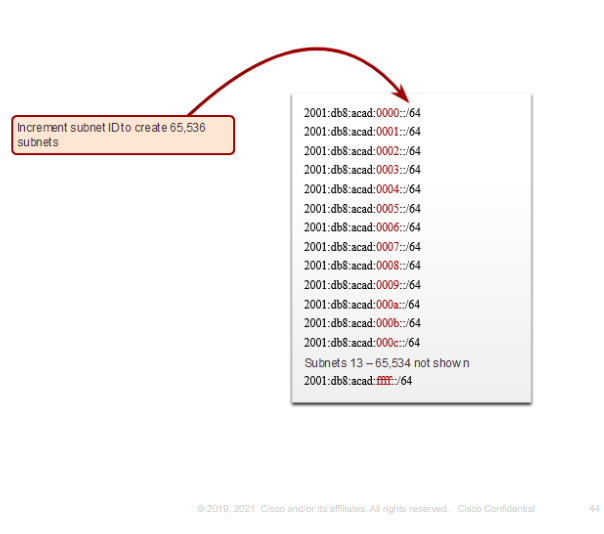

The example topology requires five subnets, one for each LAN as well as for the serial link
between R1 and R2
The five IPv6 subnets were allocated, with the subnet ID field 0001 through 0005. Each /64
subnet will provide more addresses than will ever be needed
The IETF has created various protocols and tools to help network administrators migrate their
networks to
IPv6. The migration techniques can be divided into three categories: dual stack,
tunneling, and translation
There are three types of IPv6 addresses:
unicast, multicast, and anycast
An IPv6 unicast address uniquely identifies an interface on an
IPv6-enabled device
IPv6 global unicast addresses (GUAs) are globally unique and routable on the
IPv6 internet
An IPv6 link-local address (LLA) enables a device to communicate with other
IPv6-enabled
devices on the same link and only on that link (subnet)
A device obtains a GUA dynamically through ICMPv6 messages. IPv6 routers periodically send
out ICMPv6 RA messages
every 200 seconds, to all IPv6-enabled devices on the network
RA messages have three methods:
SLAAC, SLAAC with a stateless DHCPv6 server, and stateful
DHCPv6 (no SLAAC)
The interface ID can be created using the EUI-64 process or a randomly
generated 64-bit number
The EUIs process uses the 48-bit Ethernet MAC address of the client and inserts another
16 bits in
the middle of MAC address to create a 64-bit interface ID
All IPv6 devices must have an IPv6 LLA. An LLA can be configured manually or
created
dynamically
There are two types of IPv6 multicast addresses:
well-known multicast addresses and solicited
node multicast addresses
Two commonIPv6 assigned multicast groups are:
ff02::1 All-nodes multicast group and ff02::2 All-
routers multicast group
A solicited-node multicast address is similar to the all-nodes
multicast address. The advantage of a
solicited-node multicast address is that it is mapped to a special Ethernet multicast address
IPv6 was designed with subnetting in mind. A separate subnet ID field in the
IPv6 GUA is used to
create subnets